Services on Demand
Article
Indicators
Related links
-
 Cited by Google
Cited by Google -
 Similars in Google
Similars in Google
Share
SAIEE Africa Research Journal
On-line version ISSN 1991-1696
Print version ISSN 0038-2221
SAIEE ARJ vol.114 n.2 Observatory, Johannesburg Jun. 2023
Self-Cleaning Solution for Solar Panels
M. OmarI; A. ArifII; M. UsmanIII; S. S. KhanIV; S. LarkinV
ITechnosense21 Private Limited, Islamabad, 44000 Pakistan (e-mail: omar@ts21.tech)
IITechnosense21 Private Limited, Islamabad, 44000 Pakistan (e-mail: ahmad@ts21.tech)
IIITechnosense21 Private Limited, Islamabad, 44000 Pakistan (e-mail: usman@ts21.tech)
IVNational Transmission And Dispatch Company Limited, Islamabad, 44000 Pakistan (e-mail: saadkhanopf@gmail.com)
VAfrica New Energies Limited, London, 533416 United Kingdom address (e-mail: stephen.larkin@ane.na)
ABSTRACT
The performance of photovoltaic panels is affected by the accumulation of dust particles on their surface. Regular cleaning of these photovoltaic panels is required, which increases the overall system cost and solution complexity. In remote areas, especially in water-stressed areas like deserts, water availability is an issue that double-folds the problem's complexity. Few automatic or manual dust cleaning methods through dry brushing are still there, which damages the glass layer at the top of photovoltaic panels. Here the availability of water for cleaning is not only a piece of the puzzle, but the required power to generate water in case of water harvesting is also equally important. This work proposes a novel artificial intelligence-enabled, wind turbine-driven air-water harvester. The air-water harvester is designed to operate in three different modes depending on the amount of dust on the surface of the solar panel. The system can produce more than two liters of water per day at the expense of a maximum of 100 W. In the end, the increase in the performance of the photovoltaic panel with and without the proposed cleaning solution is tested by cleaning its surface with water produced by the air-water harvester.
Open License: CC BY-NC-ND
Index Terms: air-water harvester, savonius wind turbine, solar panel cleaning, solar panel efficiency
I. INTRODUCTION
THE use of photovoltaic (PV) systems has significantly increased in the present era. The primary reason behind this increase is the shortage of non-renewable resources for electricity generation [1]. Many appliances have their variant with the solar PV phenomenon installed in them. It is expected that the applications of PV systems will further increase in the near future as the research is still improving solar panels' efficiency [2]. The transparent glass cover on the top of the solar panel collects the solar radiation from the sun and makes them enter the case. If the solar panel's transparent covering gets affected due to dust particles, the solar panel's efficiency can be compromised [3]. One of the main reasons for this is not properly cleaning the surface of solar panels [4]. Different dry cleaning methods, like brush or vacuum cleaning, can clean solar panels. Still, these methods are not very feasible as the solar panels may be mounted or some mechanism may be taking place [5]. Besides this, the brushing can also destroy the surface of the solar panel, which can further reduce the conversion efficiency [6]. Another factor that can reduce solar panel efficiency is the increase in temperature [7]. Periodic cooling can increase the efficiency of PV modules [8].
In remote areas, especially in water-stressed areas like deserts, solar-based power devices are a potential source of electricity, but due to sand and dust, the efficiency of these solar panels gets affected [9]. Water is the best natural cleaner for removing the soiling from the solar panel. Water availability in the desserts areas makes it difficult to clean the solar panels with water [10]. Water harvesting is a viable solution in water-stressed areas.
Many efficient methods for water harvesting are available, but they have pros and cons [11]. Compression-based systems have mechanical components that result in wear and tear [12]. As a result, periodic maintenance is required, which makes this method very costly [13]. Similarly, the refrigerant used in the vapour compression cycle is not environment-friendly [14]. These methods also require a high power requirement for working and, therefore, cannot be employed in remote places [15].
Some methods can produce more than 10 liters of water daily but consume a lot of power [16]. The HENDRX water generator can produce around 13 liters per day but costs 950$ and consume about 830 W. Similarly, another system, Atmospheric Water Generator (AWG), works on the refrigeration cycle [17]. This method is also not economical and costs around 3055$. The working of all these systems is based upon the vapor compression cycle. The major drawbacks of this methodology are that it is hazardous to the environment and very costly [18].
Peltier device-based cooling systems and water harvesters have been the research topic for the last few years [19]. The advantage of using Peltier action-based harvesters over conventional ones is that they do not have mechanical parts and can be operated at low power [20]. The efficiency of the Peltier-based water harvesters can be increased by using efficient heat sinks and air-guided structures.
This work proposes an AI-enabled, self-powered double chamber air water harvester for the PV cleaning solution. A specially designed wind turbine is used to power the AWH as it is environment-friendly and does not require an external source for operation. As the system is designed to increase the efficiency of the solar panels, the energy required by the cleaning system should not be taken from the pre-installed solar panels. Besides this, the wind turbine can also operate during the nighttime [21].
Unlike the conventional water production methods, the proposed design uses the effect of thermoelectric cooling for water production [22]. When the current flows through the peltier, one side becomes hot, and the other becomes cold [23]. The heat generated on the hot side is dissipated with the help of the heat sink and the DC fans. Another heat sink is attached to Peltier's cold side, accelerating condensation.
The details of the proposed PV self-cleaning solution are discussed in the following sections. The system-level working is discussed in Section II. Section III explains the design and working of the AWH. Section IV discusses the savonius wind turbine's design and working. The working of the proposed system is discussed in Section V. The results are discussed in detail in Section VI. The conclusion is summarized in Section VII.
II. SYSTEM LEVEL
The conceptual diagram of the proposed solution is shown in Fig. 1. A low RPM savonius wind turbine is used in the system as a renewable energy source. The savonius turbine will supply the necessary power to the harvester. The water produced in the AWH will be collected in the container, and the IoT sensors will determine the water level. The water level can be read, and the mobile application can control actuators through the IoT platform. The details of the AWH, savonius turbine, system integration, and mobile application are given in the following sections.

III. DOUBLE CHAMBER AIR WATER HARVESTER
The conceptual diagram of the double chamber air-water harvester is shown in Fig. 2.

The geometry consists of two sections. Each section contains one Peltier device, a PWM fan, a blower, and a pair of heat sinks. The proposed design improves the airflow control in the guided chambers and power efficiency. The design offers three different modes of operation depending upon the amount of water required to clean the solar PV panels. As a result, some power can be saved when the need for water reduces.
Different parametric experiments were performed in the air harvesting system design to analyze the harvester's performance [24]. The effect of the geometry of the cold side heat sink on water production was also investigated. Pins-fin heat sinks provide better heat dissipation, offering a larger surface area than plate-fin heat sinks [25]. In addition, heat sinks with hollow pin fins provide even better heat transfer than those without hollow pin fins [26]. For the same height of the fins, the heat sink with hollow pin fins provides better heat transfer than those without hollow fins. This concept was verified by doing the simulations on the COMSOL Multiphysics software, and the result in the form of a graph is shown in Fig. 3.

Further research was conducted on the geometry of heat sinks, and it was discovered that bio-inspired heat sinks could accelerate the condensation process on the cold side [27]. Thus, more water droplets can be generated on the surface of the heat sink. In addition, the increase in other factors like temperature, humidity, airflow, and current also helps the condensation process. In light of this concept, the heat sink with vertical channels was used for better water collection.
The pyranometer and automated actuators can also be used in the proposed design to increase the efficiency of PV panels.
The pyranometer will detect the amount of sunlight falling on the solar panel [28]. If a sufficient amount of light reaches the PV panel and the PV panel is not working efficiently, it means that dust particles are present on its surface, hindering its performance [29].
As a result, the actuator will allow the water generated by the harvester to clean the surface of the panel. On the other hand, if the pyranometer does not detect sufficient light falling on PV, the weather is cloudy, and there is no need to use the harvested water for the solar panel cleaning. The water will be stored until it is required for solar panels for cleaning. The diagram of the air-water harvester manufactured with acrylic sheets is shown in Fig. 4.

The Peltier takes 50 W to 70 W for its operation. Besides this, multiple PWM fans are used in the system. The system is divided into two chambers. Each chamber contains its PWM fan and blower. The blower takes the air from the air inlet and passes it through the fins of the hot side heat sink to provide better heat transfer. The PWM fan is used to throw the air from the hot side onto the heat sink of the cold side to help in the condensation process.
As discussed before, the amount of water required for solar panel cleaning varies depending on the dust on its surface. To save energy, three modes are designed depending on the need. The details are discussed below,
A. Economy Mode
In this mode of operation, only one blower and one PWM fan will work, and the rest will be off-state. The economy mode is programmed to save power when the water demand is low. When the dust on the solar panel is less, the economy mode can be used to save power, as shown in Fig. 5. The dark blue dotted curves represent the behavior of the economy mode. About 1 liter/day of water is produced.

B. Regular Mode
Two blowers are operational in this mode of operation and provide better heat transfer through both hot-side heat sinks. As shown in Fig. 5, about 1.35 liters of water can be obtained in regular mode. The dark red dashed curves represent the regular mode response.
C. Turbo Mode
The turbo mode is programmed for extreme conditions. This mode triggers when the efficiency of the solar panel reduces from a threshold value of 70%. This type of scenario is usually observed after heavy sandstorms. In this mode, all fans and blowers will be operational; nearly 1.6 liters of water is produced, as shown in Fig. 5. A solid black curve represents the turbo mode response.
IV. DESIGN, CALCULATIONS, AND SIMULATIONS OF SAVONIUS WIND TURBINE
The savonius wind turbine is used in the proposed design for powering the air-water harvester. unlike other types of wind turbines, the savonius wind turbine is designed to operate by receiving air from all directions and can start even at low wind speeds [30]. In addition, it does not require any external force to start [31]. The purpose of using a savonius wind turbine of less height is to reduce the visual noise and to allow installation in small areas [32]. The major drawback of the savonius wind turbine is its low efficiency [33]. The research was conducted to cope with the efficiency problem, and it was found that the savonius turbine with the two-blade rotor was much more efficient than a turbine with three blades [34].
The block diagram of the wind turbine system is shown in Fig. 6. The system's RPM is increased by coupling the gearbox with the turbine. It is coupled with the DC motor (a generator) to produce electrical voltage. The generated electrical voltage is then regulated to ensure stable current and voltage for the connected load.

A. Turbine Output Power Calculations
The equation used for the calculation of output power from the wind is given as follows:

P(electric) = Electric output power
p = air density
A = sweep area (m2)
V = Wind velocity
nm = motor efficiency
nT = turbine efficiency
Cp = coefficient of performance
Average Wind Speed = 8 m/s
After putting the values in the above equation,
The electrical power produced is affected by losses [35]. The major types of losses and their effect on the system are listed below,

The power produced by the proposed turbine is around 400 W. The details of the parameters are given in the Table I. After considering of losses discussed above, the final electric output power obtained is:


The electrical power obtained through the turbine is sufficient to power the air-water harvester discussed in Section III.
B. Pressure Contour of Wind Turbine Blades
In order to observe the effect of wind pressure exerted on the turbine blades, the analysis was made in Ansys fluent. The software generated the wind field so that wind was thrown on the blades with a velocity of 8 m/s. The high-pressure region of the turbine blades subjected to the wind speed of 8 m/s is shown in Fig. 7.

The pressure contour of the wind turbine blades is very important before making a stress-strain analysis of the different blade materials. The stress-strain analysis is applied to the region of the turbine blades where the greatest pressure is exerted. The area where the wind pressure is high is red, and the area with low air pressure is blue.
C. Stress-Strain Analysis of Wind Turbine
After finding the highest-pressure region of the turbine blades, the stress-strain analysis using different blade materials is performed. The four different materials used for the analysis in SOLIDWORKS are polycarbonate acrylonitrile butadiene styrene (PC-ABS), cast alloy steel, glass fiber, and malleable cast iron. Fig. 8 shows the strain on all four materials under the applied pressure. It can be seen that cast alloy steel and malleable cast iron show almost similar behavior and much less strain. In other words, they are less likely to deform when a strong wind hits them. In contrast, glass fiber has the highest strain magnitude and, therefore not a good choice to be used as a blade material.

The stress generated in the four materials under the influence of the externally applied pressure is shown in Fig. 9. Even though the stresses generated in cast alloy steel and malleable cast iron are greater than that of PC-ABS and glass fiber, the strain produced in the former materials is much less than the latter. The reason for this is the materials' larger ultimate tensile strength, yield strength, and hardness.

The stress-strain analysis shows that the preferred material for the turbine design can be cast alloy steel or malleable cast iron. But due to the non-availability of the materials, the glass fiber was used for the final fabrication of the wind turbine blades.
D. Design of the Savonius Wind Turbine
The savonius wind turbine was designed and tested in field conditions. The turbine blades are manufactured with glass fiber. Glass fiber was preferred over carbon fiber due to its low cost, lightweight, and material availability. The light weight of the glass fiber allows it to rotate easily at low wind speeds [36].
The turbine blades are supported on a steel shaft by drilling holes into the shaft and fixing the steel rods by welding. The turbine used in the design has an RPM of around 260. The motor or generator with the low RPM should be used for this low RPM. In the proposed design, a gear system is used to increase the RPM due to the unavailability of the low RPM motor.
The whole assembly is supported on an iron stand. The iron stand is made heavy to withstand extreme weather conditions. The final assembly is shown in Fig. 10.

The effect of wind speed on the RPM and power generated is detailed in the next section. Besides this, the effect of changing the blade diameter on the RPM is also discussed.
1) Wind Speed and Rotation of Motor
The RPM sensor was used for measuring the RPM of the DC motor. The average wind speed during the testing was observed to be 8m/s. The maximum speed was found to be 10m/s, as shown in Fig. 11. The RPM of the motor is 246 when the wind speed is 10m/s, while it is around 150 when the wind is blowing at its average speed of 8m/s. The RPM of 150 meets the requirement for the proposed design.

2) Wind Speed and Power
The graph of power generated at different wind speeds is shown in Fig. 12. At low wind speeds, the power remains zero but increases exponentially when the wind speed increases. The power of 400 W is obtained when the wind blows at 10 m/s. Some losses are also associated with turbine design; therefore, the actual electric power will be less than that obtained through the wind.
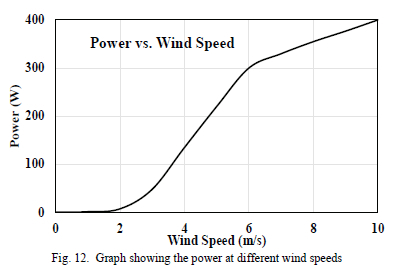
3) Effect of turbine blade diameter on RPM
Three rotor blades of different diameters were used to observe the effect of blade diameter on the RPM. It was found that with the increase in the turbine blade's diameter, the turbine's wind-capturing ability increases. Consequently, the system's RPM also increases, thus increasing the output power. The effect of using turbine blades of 19 in, 24 in, and 28 in diameter on the RPM is shown in the graph in Fig. 13.
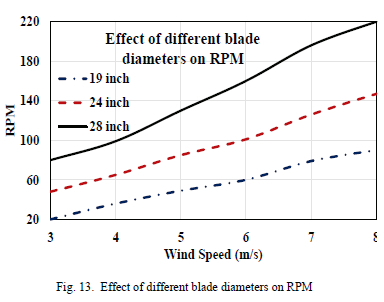
V. WORKING CYCLE OF THE PROPOSED DESIGN
The working cycle of the proposed design is shown in Fig. 14. It starts from the turbine part and ends with the solar panel cleaning.
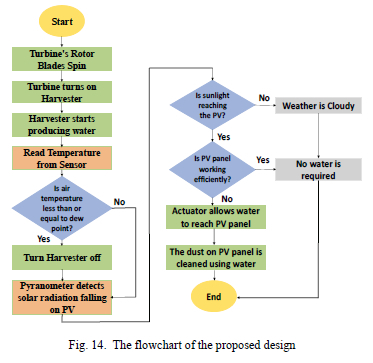
A. Rotor Blades
The turbine's rotor blades rotate when the turbine is exposed to airflow. The central shaft connected to the blades also starts to move. With the motion of the shaft, mechanical energy is produced that is used by the motor (used as a generator) to generate the electrical power.
B. Water Harvester
The power produced by the turbine produces the temperature difference across the opposite faces of the Peltier device (Thermoelectric device). The temperature difference will be exploited to produce a condensation process.
C. Dew Point Temperature
The dew point is the temperature below which the water vapors in the air condense and water droplets start forming. If the air temperature is less than or equal to the dew point, the air-water harvester can be turned off as the water droplets will naturally form. This will save energy and can be stored for use. When the air temperature exceeds the dew point, the air-water harvester will be turned on and starts the condensation process.
D. Pyranometer
A pyranometer can also be integrated with the proposed solution. In the proposed design, a pyranometer measures the radiation incident on the solar panel. Suppose no solar radiation is detected due to nighttime or cloudy weather. In that case, the AI algorithm will inform the system that the solar panel does not require cleaning and water can be saved for later use.
E. Actuator
An actuator will operate depending on the pyranometer's output and the solar panel. If the pyranometer shows sufficient radiation is reaching the panel and the PV panel is not working efficiently, there is dust on the panel's surface. Consequently, the actuator will spray the water to clean the surface of the solar panel. Otherwise, it will stop wasting water and store it for later use. The stored water can also be used for drinking if produced in excess.
VI. RESULTS AND DISCUSSION
A. Comparison of Solar Panel Efficiency before and after Cleaning
Fig. 15 shows the experimental setup of the proposed design consisting of the wind turbine, air-water harvester, and solar panel. The three different solar panels were used for testing purposes. The solar panels' efficiency before and after cleaning the dust particles from their surface was recorded in the graph, as shown in Fig. 16. The solar panels were allowed to operate for a week without cleaning the dust from their surface. At the end of the week, the efficiencies of the panels were found to be 47%, 51%, and 35%, respectively.
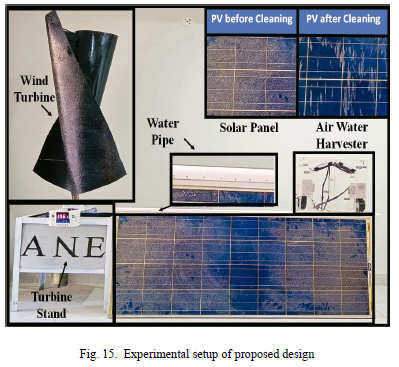
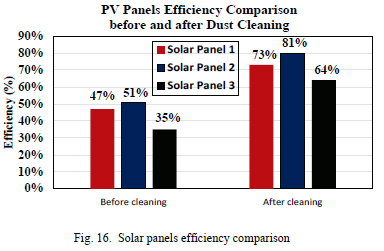
After this experiment, the same solar panels were operated again for a week, but this time they were provided with the dust cleaning facility with the help of a double chamber air-water harvester. On taking an average of efficiencies of all solar panels, a 28% increase in efficiency was observed.
B. IoT Monitoring of the different Parameters
The mobile application was developed to remotely monitor the air-water harvester's different parameters. Water level, temperature, humidity, time, and location are the parameters that can be monitored online through the app. Fig. 17 shows the mobile application's user interface.
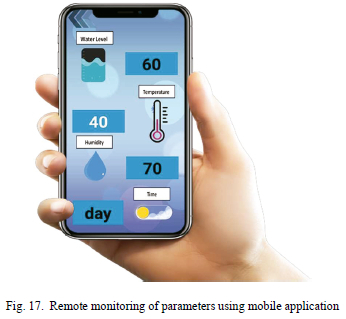
VII. CONCLUSION
This paper provides and successfully implements the solution to the solar panel cleaning problem. The proposed design can effectively clean the PV panels against dust in remote areas lacking water and electricity. The air-water harvester produced sufficient water depending upon the dust on the body of the solar panels. The wind turbine produced enough power to give supply the harvester. Besides this, the PV panel was also tested to verify the effectiveness of the proposed design.
REFERENCES
[1] F. F. Adedoyin, I. Ozturk, M. O. Agboola P. O. Agboola, and F. V. Bekun, "The implications of renewable and non-renewable energy generating in Sub-Saharan Africa: The role of economic policy uncertainties," Energy Policy, vol. 150, no. November 2020, p. 112115, 2021, doi: 10.1016/j.enpol.2020.112115.
[2] M. Mazumder et al., "Characterization of electrodynamic screen performance for dust removal from solar panels and solar hydrogen generators," Conf. Rec. - IAS Annu. Meet. (IEEE Ind. Appl. Soc., pp. 1-8, 2011, doi: 10.1109/IAS.2011.6074263.
[3] S. A. M. Said and H. M. Walwil, "Fundamental studies on dust fouling effects on PV module performance," Sol. Energy, vol. 107, pp. 328-337, 2014, doi: 10.1016/j.solener.2014.05.048.
[4] J. Farrokhi Derakhshandeh et al., "A comprehensive review of automatic cleaning systems of solar panels," Sustain. Energy Technol. Assessments, vol. 47, no. April, p. 101518, 2021, doi: 10.1016/j.seta.2021.101518.
[5] G. Aravind, G. Vasan, T. S. B. G. Kumar, R. N. Balaji, and G. S. Ilango, "A Control Strategy for an Autonomous Robotic Vacuum Cleaner for Solar Panels," Proc. - 2014 Texas Instruments India Educ. Conf. TIIEC 2014, pp. 53-61, 2017, doi: 10.1109/TIIEC.2014.018.
[6] M. G. Hudedmani, G. Joshi, R. M. Umayal, and A. Revankar, "A Comparative Study of Dust Cleaning Methods for the Solar PV Panels," Adv. J. Grad. Res., vol. 1, no. 1, pp. 24-29, 2017, doi: 10.21467/ajgr.1.1.24-29.
[7] V. B. Omubo-Pepple, C. Israel-Cookey, and G. I. Alaminokuma, "Effects of temperature, solar flux and relative humidity on the efficient conversion of solar energy to electricity," Eur. J. Sci. Res., vol. 35, no. 2, pp. 173-180, 2009.
[8] A. M. Manokar, D. P. Winston, A. E. Kabeel, and R. Sathyamurthy, "Sustainable fresh water and power production by integrating PV panel in inclined solar still," J. Clean. Prod., vol. 172, pp. 2711-2719, 2018, doi: 10.1016/j.jclepro.2017.11.140.
[9] H. Jiang, L. Lu, and K. Sun, "Experimental investigation of the impact of airborne dust deposition on the performance of solar photovoltaic (PV) modules," Atmos. Environ., vol. 45, no. 25, pp. 4299-4304, 2011, doi: 10.1016/j.atmosenv.2011.04.084.
[10] M. A. Jamil et al. , "Experimental investigations of a solar water treatment system for remote desert areas of Pakistan," Water (Switzerland), vol. 13, no. 8, 2021, doi: 10.3390/w13081070.
[11] S. Suryaningsih and O. Nurhilal, "Optimal design of an atmospheric water generator (AWG) based on thermo-electric cooler (TEC) for drought in rural area," AIP Conf. Proc., vol. 1712, no. February 2016, 2016, doi: 10.1063/1.4941874.
[12] I. Al Keyyam, M. Al-Nimr, S. Khashan, and A. Keewan, "A new solar atmospheric water harvesting integrated system using CPV/T -Stirling engine - Absorption cooling cycle and vapor compression refrigeration cycle," Int. J. Energy Res. , vol. 45, no. 11, pp. 1640016417, 2021, doi: 10.1002/er.6888.
[13] R. Tu and Y. Hwang, "Performance analyses of a new system for water harvesting from moist air that combines multi-stage desiccant wheels and vapor compression cycles," Energy Convers. Manag., vol. 198, no. July, p. 111811, 2019, doi: 10.1016/j.enconman.2019.111811.
[14] B. Monfared, R. Furberg, and B. Palm, "Magnetic vs. vapor-compression household refrigerators: A preliminary comparative life cycle assessment," Int. J. Refrig., vol. 42, pp. 69-76, 2014, doi: 10.1016/j.ijrefrig.2014.02.013.
[15] T. Anbarasu and S. Pavithra, "Vapour compression refrigeration system generating fresh water from humidity in the air," IET Conf. Publ., vol. 2011, no. 583 CP, pp. 75-79, 2011, doi: 10.1049/CP.2011.0338.
[16] S. I. Chou, J. H. Bae, F. Friedmann, and J. D. Dolan, "Development of optimal water control strategies," Proc. - SPE Annu. Tech. Conf. Exhib., vol. Sigma, no. pt 1, pp. 41-47, 1994, doi: 10.2118/28571-ms.
[17] Z. Almusaied and B. Asiabanpour, "Atmospheric water generation: Technologies and influential factors," 67th Annu. Conf. Expo Inst. Ind. Eng. 2017, pp. 1448-1453, 2017.
[18] O. U. Aamer, A. Sajid, S. Walayat, M. Omar, and R. Ramzan, "Green Self-Powered Air-Water Harvester," pp. 1-4, 1900.
[19] H. Najafi and K. A. Woodbury, "Optimization of a cooling system based on Peltier effect for photovoltaic cells," Sol. Energy, vol. 91, pp. 152-160, 2013, doi: 10.1016/j.solener.2013.01.026.
[20] Y. Ivanov et al., "Advantages of water-cooled Peltier current leads for HTS devices," Mater. Today Proc., vol. 5, no. 4, pp. 1040810412, 2018, doi: 10.1016/j.matpr.2017.12.289.
[21] G. P. Van Den Berg, "Effects of the wind profile at night on wind turbine sound," J. Sound Vib., vol. 277, no. 4-5, pp. 955-970, 2004, doi: 10.1016/j.jsv.2003.09.050.
[22] D. Zhao and G. Tan, "A review of thermoelectric cooling: Materials, modeling and applications," Appl. Therm. Eng. , vol. 66, no. 1-2, pp. 15-24, 2014, doi: 10.1016/j.applthermaleng.2014.01.074.
[23] M. A. Munoz-Garcla, G. P. Moreda, M. P. Raga-Arroyo, and O. Marín-González, "Water harvesting for young trees using Peltier modules powered by photovoltaic solar energy," Comput. Electron. Agric., vol. 93, pp. 60-67, 2013, doi: 10.1016/j.compag.2013.01.014.
[24] A. H. Shourideh, W. Bou Ajram, J. Al Lami, S. Haggag, and A. Mansouri, "A comprehensive study of an atmospheric water generator using Peltier effect," Therm. Sci. Eng. Prog. , vol. 6, pp. 1426, 2018, doi: 10.1016/j.tsep.2018.02.015.
[25] D. K. Kim, S. J. Kim, and J. K. Bae, "Comparison of thermal performances of plate-fin and pin-fin heat sinks subject to an impinging flow," Int. J. Heat Mass Transf., vol. 52, no. 15-16, pp. 3510-3517, 2009, doi: 10.1016/j.ijheatmasstransfer.2009.02.041.
[26] E. A. M. Elshafei, "Natural convection heat transfer from a heat sink with hollow/perforated circular pin fins," Energy, vol. 35, no. 7, pp. 2870-2877, 2010, doi: 10.1016/j.energy.2010.03.016.
[27] X. Ma, P. Cheng, and X. Quan, "Simulations of saturated boiling heat transfer on bio-inspired two-phase heat sinks by a phase-change lattice Boltzmann method," Int. J. Heat Mass Transf., vol. 127, pp. 1013-1024, 2018, doi: 10.1016/j.ijheatmasstransfer.2018.07.082.
[28] M. A. Martinez, J. M. Andújar, and J. M. Enrique, "A new and inexpensive pyranometer for the visible spectral range," Sensors (Switzerland), vol. 9, no. 6, pp. 4615-4634, 2009, doi: 10.3390/s90604615.
[29] M. Garcia, L. Marroyo, E. Lorenzo, and M. Pérez, "Soiling and other optical losses in solar-tracking PV plants in navarra," Prog. Photovoltaics Res. Appl., vol. 19, no. 2, pp. 211-217, 2011, doi: 10.1002/pip.1004.
[30] N. Korprasertsak and T. Leephakpreeda, "Analysis and optimal design of wind boosters for Vertical Axis Wind Turbines at low wind speed," J. Wind Eng. Ind. Aerodyn., vol. 159, no. September, pp. 918, 2016, doi: 10.1016/j.jweia.2016.10.007.
[31] M. Zemamou, M. Aggour, and A. Toumi, "Review of savonius wind turbine design and performance," Energy Procedia, vol. 141, pp. 383-388, 2017, doi: 10.1016/j.egypro.2017.11.047.
[32] R. Kumar, K. Raahemifar, and A. S. Fung, "A critical review of vertical axis wind turbines for urban applications," Renew. Sustain. Energy Rev., vol. 89, no. September 2016, pp. 281-291, 2018, doi: 10.1016/j.rser.2018.03.033.
[33] J. V. Akwa, H. A. Vielmo, and A. P. Petry, "A review on the performance of Savonius wind turbines," Renew. Sustain. Energy Rev., vol. 16, no. 5, pp. 3054-3064, 2012, doi: 10.1016/j.rser.2012.02.056.
[34] R. V. Bethi, P. Laws, P. Kumar, and S. Mitra, "Modified Savonius wind turbine for harvesting wind energy from trains moving in tunnels," Renew. Energy, vol. 135, pp. 1056-1063, 2019, doi: 10.1016/j.renene.2018.12.010.
[35] A. Naseem et al., "Effect of vortices on power output of vertical axis wind turbine (VAWT)," Sustain. Energy Technol. Assessments, vol. 37, no. March 2019, p. 100586, 2020, doi: 10.1016/j.seta.2019.100586.
[36] S. F. Pamungkas, D. S. Wijayanto, H. Saputro, and I. Widiastuti, "Performance 'S' Type Savonius Wind Turbine with Variation of Fin Addition on Blade," IOP Conf. Ser. Mater. Sci. Eng., vol. 288, no. 1, 2018, doi: 10.1088/1757-899X/288/1/012132.
The work was supported in part by Africa New Energies Limited, UK, under Grants ANE040 and ANE047.

M. Omar is the founder of Technosense21 Private Limited. The company primarily focuses on cutting-edge research and patents innovative ideas. His core expertise lies in Passive RF designing, 5G/6G challenges, and Passive component designing for CMOS ICs. He has a Master's degree in Electronics Engineering and has more than 13 years of Research and Development (R&D) experience, including international and national experience. He has done multiple engineering projects and has deep knowledge of engineering challenges at the system and component levels. He has more than 60 publications, which include journals and international conferences. He is the inventor of a few US, UK and African Patents.

A. Arif received a BS degree in electrical power engineering from the University of Engineering and Technology, Taxila, Pakistan, in 2021. He received a gold medal for his outstanding performance in BS. His research interests are electrical and power electrical.

M. Usman received a BS degree in electrical and computer engineering from the National University of Computer and Emerging Sciences, Islamabad, Pakistan, in 2020. After graduation, he joined a research firm and enrolled as an inventor and author of patent and research articles. He worked as a Project Manager and led a team of young engineers for cutting-edge research and development. He is currently a Chief Technical Officer at Technosense21 Private Limited, Pakistan. His research interests are electrical, RF, IoT, and embedded systems.

S. S. Khan received his BS and MS degrees in electrical engineering power from the University of Engineering and Technology Lahore, Pakistan. He completed his PhD in 2019 from United Arab Emirates University, UAE. He is a part-time PostDoc researcher at United Arab Emirates University and Deputy Manager of Technical at National Transmission and Despatch Company Limited, Pakistan. He is researching applications, modelling and fault diagnosis of the fuel cell.

S. Larkin is a trained economist who has started his career with assignments at Unilever's Finance, British Airways Fuel Finance and GE Capital's Treasury Teams. Since 2004 he has been helping disadvantaged entrepreneurs to start businesses in South Africa. His Oil and Gas Exploration Company, Africa New Energies, has been awarded two oil and gas blocks in Namibia after advising their national and other African governments on energy security strategies. Based on two recent offers, the company is targeting a valuation of over $1 billion on its IPO in 2024. His specialities include PFI modelling; Heuristic algorithms; Techno-economic analysis; Project finance structuring; Energy resource modelling; Energy technology innovation; and Strategic business planning.














